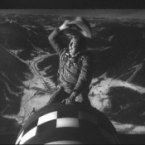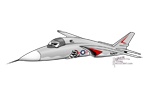
When arranging ships in a naval formation, certain units should be placed so that they can best deal with incoming threats. In other words, they should be placed on threat axes between high-value units and potential threats.
Surface and subsurface threats will generally approach from the front of the formation, if only because the formation is moving away from the rear quadrants. However, if the threats move much faster than the formation, as aircraft do, they could come in from any direction. In fact, the aircraft SHOULD come in from whatever direction gives them the best advantage. The ships will be unable to respond quickly enough, and the formation must be treated as being static.
There will be situations where the aircraft can only approach the formation from one direction. This will primarily be due to the target being far from the airbase. (see Fig. 1) There will be other situations where the flight path of the aircraft is somewhat restricted, and there could be many reasons for this. There could be situations where the flight path of the aircraft is not restricted for any physical reason, but is restricted by doctrine or a more temporary choice. For purposes of this discussion, I am assuming that none of these considerations apply, and the aircraft actually can approach the formation from any direction. (see Fig. 2)


Just to make things a little more specific, let’s assume that the aircraft want to approach the formation from a direction that avoids the nastiest air defence unit (NADU, eg. a Bunker Hill or a Kirov) as much as possible. This means that the aircraft will have to fly around the perimeter of the formation to reach the best attack point. The NADU will typically have long-range SAMs, and that range depends on the unit. However, all ships have a radar horizon of about 50 nm, and all aircraft can safely approach the ship that far at low altitude. What additional distance must the aircraft travel in this case?
The additional distance depends on how far away the airbase is. However, if the airbase is far away, the additional distance from point A to B will be approximately the safe distance R from the NADU. (see Fig. 3) Then the aircraft will fly around the perimeter of the formation from B to C, and that distance is 1.57 x R. The aircraft will also have to return, so, at most, the total additional distance is 2 x (R + 1.57 x R) = 2 x R x 2.57 = 257 nm. The practical additional distance will be slightly larger, primarily for safety reasons.

The attacking aircraft can come in from whatever direction gives them the advantage. If the formation is arranged to be strongest from some direction, then it will be weaker from other directions. Therefore the formation needs to be arranged in as symmetric a fashion as possible. (see Fig. 4) This applies not only to the NADU, but also to the other units with air defence capacity. As corollary to this statement, the formation also needs to be packed fairly tightly. (There may be a competition between the requirements for air defence and subsurface defence. Defence against surface threats will follow similar principles to air defence.)











